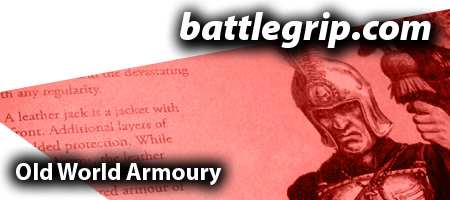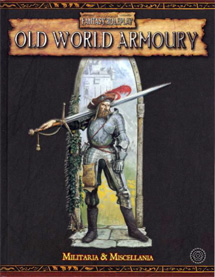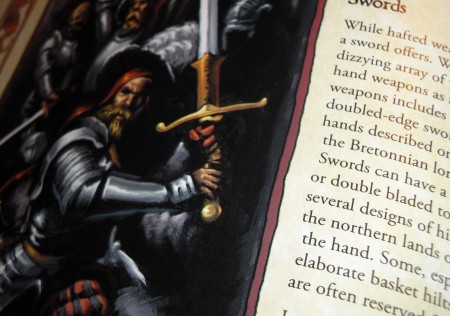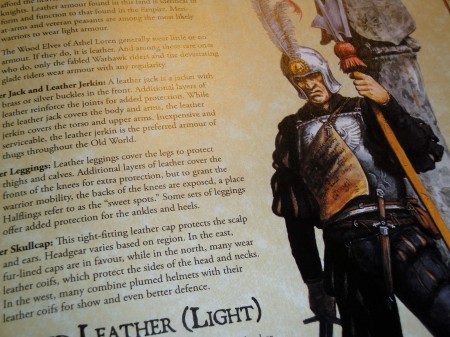Reading – Old World Armoury

NOTE: This is another older review that I’m posting here in an attempt to collect my online writings in one place.
Published in 2005, shortly after the release of the game’s second edition rulebook, the Old World Armoury* is a 128-page hardcover sourcebook covering equipment, hirelings, lands and businesses, and other things that money can buy in the world of Warhammer. The book has been the target of some debate amongst Warhammer Fantasy Roleplay* fans (this review at RPGnet is worth reading if you’re interested in why some players dislike the book) though I personally feel that it is a well-written sourcebook and a worthy addition to the game line. (Despite the fact that some of the material is directly reprinted, or expanded, from the core rulebook. Read on to see what I’m talking about.)

Visuals
Before discussing the book’s interior design and appearance, I’ll start with the cover which, while adequate, is not as exciting as some of the other covers in the series. (The absolute best cover in the series has got to be Ozan Art’s work on The WFRP Companion*; that image, depicting a tentacle monstrosity attacking a ship, is my personal favorite of all of the Warhammer Fantasy Roleplay* covers.) Showing an armored warrior with an overly-long sword, Dave Gallagher’s cover image is, in my opinion, the weakest piece of color work in the entire book. It’s unfortunate, but in no way does it damage the book’s interior.

Once beyond the cover, the Old World Armoury* – which follows the same graphic design as the core rulebook – follows a clean and attractive design that’s easy on the eyes. (This is true of all of the books in the series, both color and B&W.) The book is packed with both color and B&W artwork – few spreads do not have at least one image – and most of the work is exceptional and well-suited to the book’s text (which is not uncommon for all of the books in the line). Overall, this book upholds the visual standards of the line and is a pleasure to look at.
Between the Covers
The Old World Armoury* is broken into ten chapters and an appendix. By the numbers, the book contains:
Chapter One: Currency & Trade. Subdivided into sections covering coins, forgery, barter and trade, and taxation, this 9-page chapter provides players with the basic tools they’ll need to buy and sell during the course of a game session (those interested in taking a closer look at the art of trade in Warhammer Fantasy Roleplay will want to read Jude Hornborg and Dan White’s detailed “Advanced Trade and Commerce†in The WFRP Companion, though that work takes the subject of trade much further than many players will ever need.) The taxes described – which include taxes on elves ears, the length on a person’s belt, and standing more than 4-feet tall – are fun to read and should act as a source of inspiration for gamemasters looking at writing their own taxes. Much of what’s in this chapter is applicable only to actual roleplaying, and players in search of gear for their characters will feel the need to move on quickly to the next chapter.
Chapter Two: Old World Armour. Expanding on the (approximately) three-pages on armor found in the core rulebook, this 11-page chapter provides players with more information (which may or may not be valuable, depending on your personal needs). As a comparison, consider these two descriptions of leather leggings.
Warhammer Fantasy Roleplay Description: “This type of armour protects the legs, reinforcing the knees and offering protection for the ankles and heel. Leather leggings are included in full leather armour.â€
Old World Armoury Description: “Leather leggings cover the legs to protect thighs and calves. Additional layers of leather cover the fronts of the knees for extra protection, but to grant the warrior mobility, the backs of the knees are exposed, a place Halflings refer to as the ‘sweet spots.’ Some sets of leggings offer added protection for the ankles and heels.â€
As you can see, the descriptions are very similar, with the description from the Old World Armoury* providing just a little more detail and flavor. The game statistics for leather leggings in both books are identical.
The chapter also includes a section on heraldry and a section on damaging and repairing armour (which, while interesting, adds a little more complexity to the game than some groups will be interested in).

Chapter Three: Arms of the Old World. As with chapter two, this chapter is about expanding on the details found in the core rulebook – taking 6-pages of material and enough information to bulk it up to 16-pages. The expansion in this case is less in terms of expanded weapon descriptions than it is actual content – rules for jousting and damaging weapons are included in this chapter – though some of the weapon descriptions have been slightly expanded and reworded. One large difference between the weapon sections of the two books is the fact that gunpowder weapons, while lumped in with all of the other weapons in the core rulebook, are broken into a different chapter in the Old World Armoury*. In fact, the very next chapter just so happens to be . . .
Chapter Four: Gunpowder & Weapons of War. If you have any interest at all in firearms or war machines in the >Warhammer setting, and in incorporating those devices in your campaign, this is the chapter you’ll want to refer to. Again, expect to see some of what you’ve already seen in the core rulebook along with new material (such as the Advanced Misfires table and the heavy war machines).
Chapter Five: General Equipment. As with earlier chapters in the book, much of the information in this chapter is an expansion on what appears in the core rulebook. Some specific additions (rather than simple expansions) include musical instruments, boxed text covering clothing color and social status (a trick I used in A Dozen Unusual Articles of Clothing), and a section on reading and writing equipment. Personally, these duplications and expansions don’t bother me, since it just means that all of the information is in a single location, though I know that some people would have preferred that material from the core rulebook remain there and not be reprinted here.
Chapter Six: Special Equipment. Take three pages from Warhammer Fantasy Roleplay, add in some new material, and you have this 10-page chapter of the Old World Armoury*. Most of the draughts (non-magical, potion-like drinks), poisons, oddities (unusual equipment that doesn’t fall neatly into any other category), and appendage replacements from the core rulebook are reprinted here, along with a substantial number of new items and a section on “Religious Paraphernalia.†(I am not sure why the earring entry in the core rulebook was not reprinted in the Old World Armoury*, but other than that, it looks as if every item in the core rulebook made its way into these pages.)
Chapter Seven: Animals & Transport. Including statistics for eleven different pets and mounts, as well as statistics and detailed information on vehicles and vehicular combat, this chapter of the book will come in handy whenever you decide to run a rolling battle as the players race their horses and carts down a dusty road. And for those times in which the players are simply moving from point A to point B, the expanded information on roads and travel in the Old World will be quite useful. Additionally, a brief section on barding will help players in purchasing armor for their mounts (always handy when you expect to run into trouble on the road).

Chapter Eight: Property & Business. Weighing in at 8-pages, this chapter lets the players take part in land speculation and commerce (if they’re interested in such things) in the campaign, with costs and guidelines for renting a home or a single night in an inn or tavern, buying everything from the worst parcel of rural land to the best acreage in the city, costs to place a home on that land, and what it costs to build and run a business. A listing of suggested businesses – from Accountant to Wheelwright – closes out the section. Any players who are serious about running a business in the setting, or are merely interested in adding a feeling of authenticity to their campaign, should consider checking out the non-game book, Life in a Medieval City*. (A book, I am not ashamed to admit, has inspired me on more than one occasion.)
Chapter Nine: Hiring Characters. As the book says, “At some point in a character’s career, he’ll want help.†That’s where this chapter comes in. 16-pages long, this chapter provides descriptions and statistics for both hirelings (common folk who can be hired to perform a specific task) and henchmen (dedicated followers who are willing to set off on adventurers with the player characters, though they’re not puppets and must be treated with respect or else they’ll find a new master), as well as costs associated with hirelings, rules covering the loyalty of henchmen, and optional rules for medical treatment. Information on “Fleshing out Henchmen†is provided for gamemasters who are pressed for time.
Chapter Ten: Treasures of the Old World. A very short chapter (only four-pages), this final chapter of the book presents rough information on unusual coins, gemstones, jewellery, and “valuable goods.†As a fan of treasure items in roleplaying games (I’ve written more than a few PDFs devoted to treasure), I found this chapter far too brief. The tables, while useful, provide just enough information to get a gamemaster started, but this chapter is more of a set of guidelines than it is a catalog of treasure items. That’s not an entirely bad thing, but I would have enjoyed reading about (specific) unusual treasures of the Warhammer* setting.
Appendix: Reference Tables. Many of the book’s most important tables (though not all of the tables in the book) are reprinted across 10-pages. While this is semi-useful, I personally would have rather seen another 10 pages of material rather than reprinted tables. Still, I can see where some people would find this useful so while I may not like this appendix I can see why it was included. (And after reading the Adventurer’s Vault* for Dungeons & Dragons*, which I’ve started reading but haven’t completely absorbed, 10-pages devoted to reference is a tiny amount in comparison to that book’s 25-page index of magic items by level)

I Pass Judgment
While not an absolute necessity to run (or play in) a Warhammer Fantasy Roleplay adventure – the core rulebook provides enough information and statistics on equipment for most basic adventures – those who wish to play in a long-term campaign, or anyone searching for more detailed equipment options as well as information on trade and rules for henchmen and hirelings, will find the Old World Armoury* a valuable addition to their library.
Related articles
- Reading – Old World Bestiary (battlegrip.com)
- New Warhammer 40K Novella, Yarrick: Chains of Golgotha (battlegrip.com)
- Warhammer Fantasy Special Characters Supplement Released (unofficial) (tabletopgamingnews.com)
